1915-1939
On-campus housing returned to UNI in 1915 when the school's first residence hall, Bartlett Hall, was completed. Female students then had the choice of living on campus in this hall or in boarding houses. Until 1936, boarding house living was the only option for male students.
To learn more about housing at UNI, choose one of the following time periods or continue scrolling to begin with 1915.
1915-1919
The first wing of Bartlett Hall provided living space for between 120 and 130 female students.
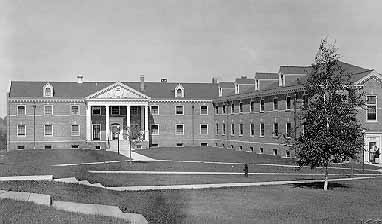
The students rented their rooms by quarters, or every 12 weeks. The charge for the rooms depended on the number of people sharing the space and the number of windows in the room.
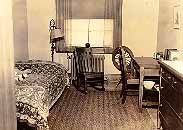
In 1916, the cost for a single room for one person, as in the photo to the right, was $24.00. A room for two people with two windows cost $42.00, whereas a room with only one window for the same number of people cost $36.00. The rooms each included a bed with mattress and pad, rocking chair, study chair, closet, library table, hot/cold water, and "semi-indirect" electric lighting.
After the second wing was completed in 1916, over 300 women were housed in Bartlett Hall.

One tradition at Bartlett Hall was the lighting of the fireplace.
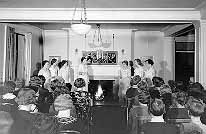
It began November 25, 1916 when the residents lit the fireplace in the new building for the first time. The students stood in a circle holding candles and passed a lighted candle while singing the Bartlett Hall Song. After all candles were lit, the fireplace was ignited.
Although a Dean of Women, Marion McFarland Walker, was appointed in 1908, a supervisory system for men students was not established until 1913. In that year a Men's Advisory Council began meeting to address concerns. However, because of the great increase in behavior problems of men students, a full time Advisor of Men, Leslie I. Reed, was hired in 1916. In addition to advising students, he also had instructional duties.
1920s
In 1923, the third wing of Bartlett Hall was completed, allowing over 500 women to live on campus.

This decade brought two changes in student support personnel. In 1924, Leslie Reed became the first Dean of Men. The position was similar to his previous position in almost all aspects, except he no longer had to teach. He remained in this position until 1945. On September 1, 1929, Sadie B. Campbell was named the new Dean of Women after Marion McFarland Walker resigned. Campbell Hall, which was constructed in 1953, was named for this Dean of Women.
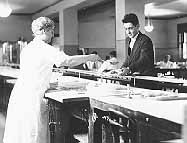
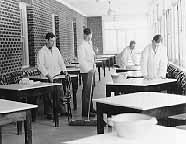
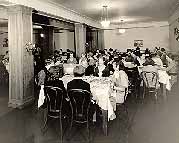
The cafeteria was described in the 1920-21 ISTC Bulletin as being more like a restaurant. It was open to all faculty, staff, and students, in addition to those living in the Hall. The dining room had more of a homey atmosphere and was open only to the residents. The food in the dining room was less costly than the cafeteria and a more nutritionally balanced selection was offered. In 1923, non-Bartlett residents and faculty could eat in the dining room if there were openings.
Rooming house regulations had not changed too much by the late 1920s. Students still could only live in accredited houses and had to follow strict conduct rules. In April 1927, the requirements for accreditation of houses included:
- A responsible manager must be in charge of the house
- The manager is responsible for the conduct of his/her roomers and has to report their misconduct
- Men and women may not live in the same house
- The house must be hygienically clean
- The rooms must have the required furniture (ex. single beds)
- The house must have one bathroom for every 12 people; the toilets must be separate and screened; hot water must be available; a night light must be present; family must have a separate bathroom
- A parlor must be provided for students.
By September of that same year, the college gave the owners of the houses a little leeway by requiring only 1/3 of the rooms to have single beds.
1930s
With the 1930s came changes in food service, better telephone service for Bartlett Hall, and, finally, housing for men.
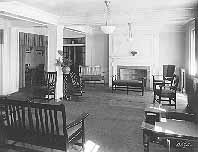 Beginning in the fall of 1930, students eating in the Bartlett Hall dining room were required to dress for dinner. The students would gather in the middle parlors, such as the one to the right, at 6:00 p.m. They would move to the dining room together where they were all served at the same time.
Beginning in the fall of 1930, students eating in the Bartlett Hall dining room were required to dress for dinner. The students would gather in the middle parlors, such as the one to the right, at 6:00 p.m. They would move to the dining room together where they were all served at the same time.
Early in 1932, improvements were made in telephone service at Bartlett Hall. Previously, students who wanted to make or receive calls had to go to the main office where the only phone was located. This created many inconveniences such as lengthy hold times while a student was being fetched and a busy line. To overcome this, they installed a "private branch exchange system" which connected 16 new phones in the building. This improvement made Bartlett Hall one of the more advanced residence halls in the United States.
In 1932, plans were approved to expand the dining service available to students by erecting a new building. This building, later named the Commons, would serve as the only dining service on campus and would also be used as a recreational center. Some individuals in the College Hill area opposed the new building because it would decrease the number of students who bought their meals at rooming houses and Hill restaurants. This opposition did not stand in the way of construction. The building was completed and began serving students in 1933.
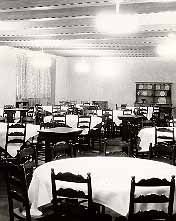
Shortly thereafter, dining service at Bartlett Hall ended.
In March of 1936, administrators announced a change in women's housing. The two west wings of Bartlett Hall were to be used exclusively to house first year freshmen women. A senior or junior student was assigned a corridor in these wings in which to live and serve as an advisor and leader to the younger students. The Bartlett Hall Council hoped this step would build "spirit and loyalty within the class" (College Eye 4/3/36 p. 1). Part of this new system is still in force today. Resident Assistants (R.A.s) still serve as advisors and leaders for the students in their dormitory houses.
An important event occurred in 1936 which greatly altered men's housing at the Iowa State Teachers College. It was the year male students had been waiting for since 1915. That summer the first men's residence hall was completed. The George T. Baker Hall for Men housed around 111 male students, in both single and double rooms.
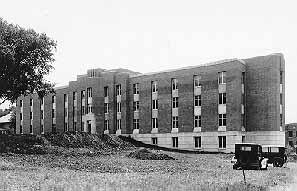
Unlike the women's dorms, no food service was provided for Baker Hall. Students had to walk to the Commons to take their meals.
An article in the November 12, 1937 issue of The College Eye student newspaper reported that drinking had increased in the hall (drinking of milk, that is). The milkman would leave quart bottles of milk outside double rooms and pint bottles outside single rooms. In order to get more sleep before an early class, the residents would drink milk for breakfast and forgo the timely trip to the Commons for a sit-down meal. Although Dean of Men Leslie Reed stated that he didn't "favor the plan of the boys drinking their milk in their rooms" he allowed the practice to continue.
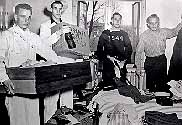
In 1938 a second men's dormitory of similar design was completed. The Homer H. Seerley Hall for Men created space for an additional 119 male students to live on campus. It was constructed just east of Baker Hall, leaving room for an addition to be constructed between the two halls at a later date.
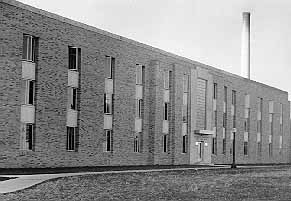
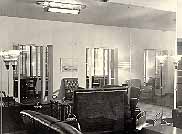
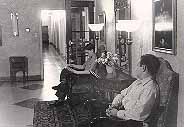
After the depression, the enrollment of women at the ISTC grew. By the late 1930s, administrators saw the need for additional housing for women students. The extent of the need was evident in 1937 when nearly 300 applicants for housing were turned away for lack of space. Construction began in 1939 on a new women's hall which would create room for nearly 300 students. The hall was built west of the Commons and was similar in design to Bartlett Hall. This building is named Lawther Hall today and houses all gender students.
Created by Susan Witthoft
Special Collections and University Archives
March 1997
